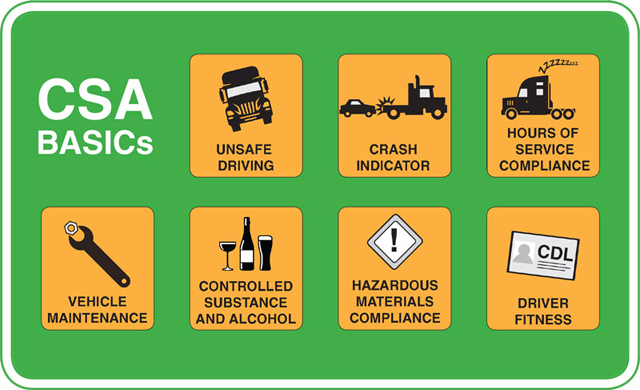Managing CSA

This story appears in the September 12 print edition of iTECH, a supplement to Transport Topics.
Despite the removal of Compliance, Safety, Accountability scores from public view late last year, many shippers and third-party logistics providers remain eager to track carriers’ safety performance, and technology providers are helping to fill that void.
The Federal Motor Carrier Safety Administration withdrew CSA’s percentile scores and relative comparisons among motor carriers in December as required by the FAST Act, the five-year highway law enacted at the end of 2015. FMCSA returned the program’s raw safety data to public view in March, but shippers, logistics firms and insurers continue to seek more specific safety information on carriers.
BEST OF SEPTEMBER iTECH: More stories, columns
However, some fleets said they’re reluctant to share their full CSA scores because of what they see as flaws in the program’s methodology.
Derek Ohata, director of compliance for C.R. England Inc., said he frequently receives requests for scores. In fact, some of the carrier’s existing customers still require the information.
“We made the decision that if there is an agreement in place, we still provide the old public BASICs [Behavior Analysis and Safety Improvement Categories]. To others, we tell them they’re no longer public,” he said.
The fleet, which ranks No. 23 on the Transport Topics Top 100 list of the largest U.S. and Canadian for-hire carriers, also stopped sharing its scores internally as part of its monthly newsletter and now provides the scores to its safety employees only.
Irwin Shires, government qualification coordinator for Panther Premium Logistics, also said shippers continue to ask for carriers’ CSA scores.
“Shippers know the scores are still there but that they aren’t on the website,” he said.
Several technology suppliers offer management tools designed to help carriers, shippers and logistics providers navigate CSA and understand fleets’ safety performance.
Vigillo, for one, has developed its own parallel safety scoring system aimed at addressing several “fundamental flaws” in CSA by accounting for factors such as crash preventability and differences in state enforcement.
CEO Steve Bryan said Vigillo’s business actually has grown since CSA scores were withdrawn from public view.
While the removal of scores hasn’t changed the way Vigillo operates, it has meant that carriers are not able to benchmark themselves against their peers as easily.
“They realized that if they’re going to continue to benchmark themselves, they need help,” Bryan said. “The way to improve your CSA score is to compare yourself to those around you, and now they’ve lost that visibility.”
Despite its flaws, CSA has improved the safety culture within the trucking industry, Bryan said.
“Even though the scores are not as public and may not have as much emphasis on them, the industry has come to understand the focus is there,” he said.
Another company, SaferWatch, has launched a CSA-equivalent scoring program that uses FMCSA’s published Safety Measurement System methodology along with additional data to generate its CSA-e percentile scores.
“We all know there has been much controversy over the CSA scores, but many believe there is not much else available to help determine carrier safety,” said Mark Draeb, president of Grizella Corp., the parent company of SaferWatch.
SaferWatch’s clients can use the data to assess carriers’ risk, he said.
Jim Dykstra, logistics manager for Boar’s Head, a provider of deli meats and cheeses based in Petersburg, Virginia, turned to SaferWatch to gain information on carriers after scores were taken down.
“We were left in the dark once again,” Dykstra said, adding that not knowing is no excuse. “Knowledge is insurance against liability, and the removal of public scores forced additional work in obtaining information with which to make business decisions.”
Insurance companies also are interested in using safety scores to assess insurability and mitigate risk, said SaferWatch’s Draeb.
Paul Hanson Partners, a provider of risk management and insurance placement services to the transportation industry, uses SaferWatch data and CSA-e scores that fall below a certain threshold to drive video education to those they insure.
To better share safety data between shippers and carriers, EBE Technologies and Vigillo have partnered to create an integrated carrier onboarding and compliance management product for the companies’ mutual logistics clients.
With the new integration, joint customers of EBE and Vigillo can receive CSA BASIC data in real time, providing insight into a carrier’s performance.
Larry Kerr, president of EBE Technologies, said the partnership will make CSA data much quicker to access, and users will have an accurate and current representation of a carrier’s performance.
“The ability to seamlessly access a carrier’s CSA score from Vigillo and use it as a component of the vetting process is going to allow logistics providers to make better and faster onboarding decisions,” he said.
When it learned that CSA scores were going dark, Transportation Performance Inc., a provider of fleet management software, updated its safety performance module by incorporating the carrier’s definition of preventable accidents and critical event reporting on items such as speeding, hard braking and roll stability.
“Our ultimate goal is to be preventive and reduce safety events that become roadside violations,” said Mark Martin, president of Transportation Performance.
Less-than-truckload carrier Pitt Ohio, on the other hand, did not make any adjustments to its proprietary SafetyBox software, a comprehensive driver management system that tracks CSA data in real-time, or to its overall approach to safety, said Jeff Mercadante, vice president of safety for the company that ranks No. 48 on the for-hire TT100.
“We’re a pretty hands-on company, and we monitor every aspect of our operations, which includes safety,” Mercadante said. ³

